VOLVO XC60 2009 Owner´s Manual
Manufacturer: VOLVO, Model Year: 2009, Model line: XC60, Model: VOLVO XC60 2009Pages: 297, PDF Size: 21.16 MB
Page 241 of 297
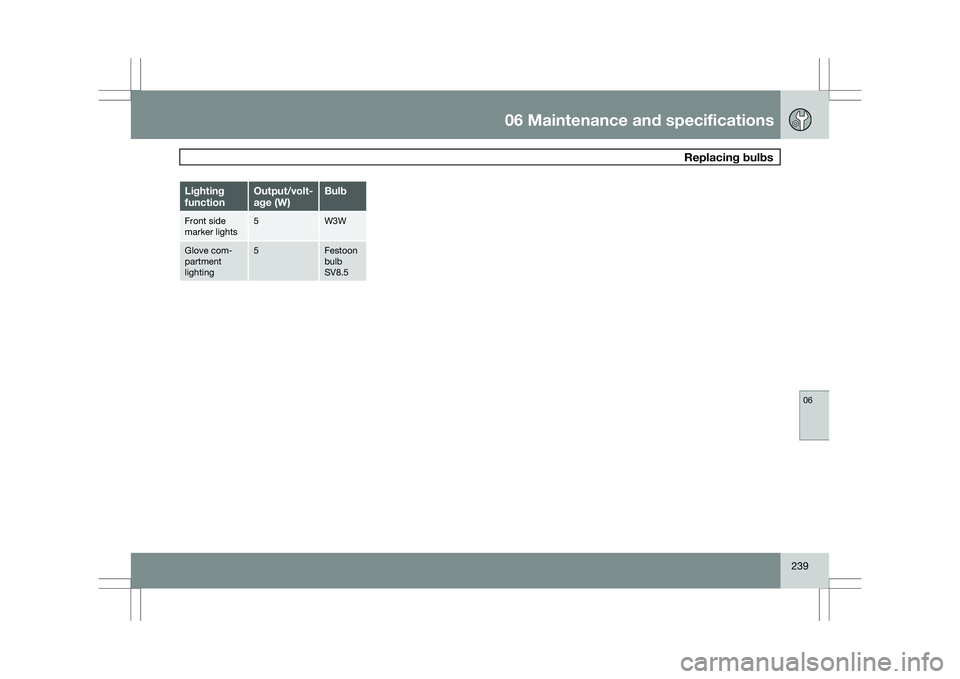
06 Maintenance and specifications
Replacing bulbs06
239Lighting
function Output/volt-
age (W) Bulb
Front side
marker lights 5 W3W
Glove com-
partment
lighting 5 Festoon
bulb
SV8.5
Page 242 of 297
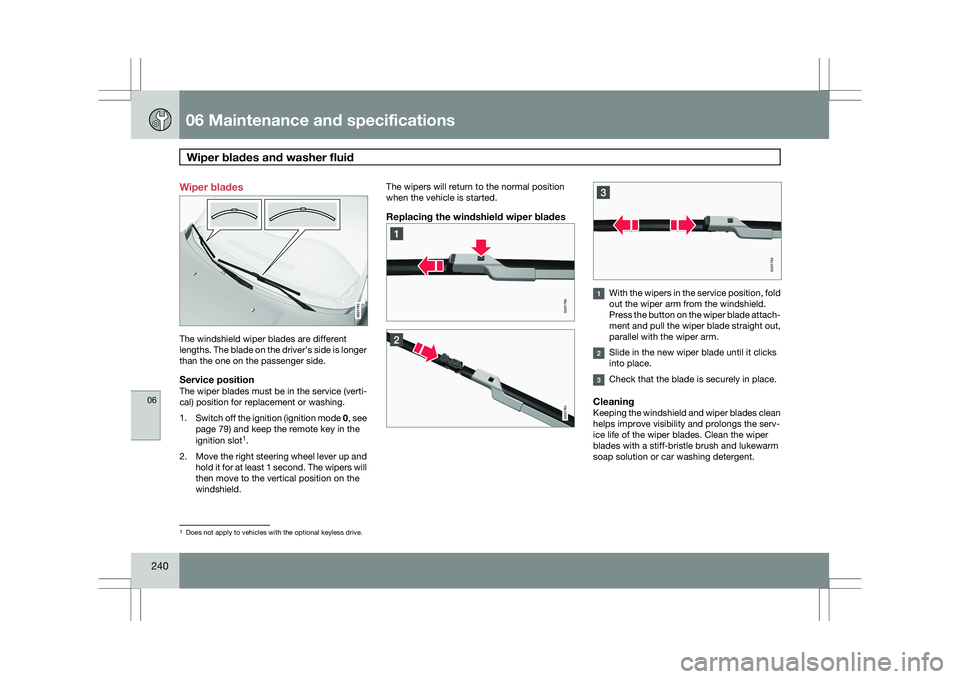
06 Maintenance and specificationsWiper blades and washer fluid 06
240 Wiper blades
The windshield wiper blades are different
lengths. The blade on the driver’s side is longer
than the one on the passenger side.
Service positionThe wiper blades must be in the service (verti-
cal) position for replacement or washing.
1.
Switch off the ignition (ignition mode 0, see
page 79) and keep the remote key in the
ignition slot 1
.
2. Move the right steering wheel lever up and
hold it for at least 1 second. The wipers will
then move to the vertical position on the
windshield. The wipers will return to the normal position
when the vehicle is started.
Replacing the windshield wiper blades
With the wipers in the service position, fold
out the wiper arm from the windshield.
Press the button on the wiper blade attach-
ment and pull the wiper blade straight out,
parallel with the wiper arm.
Slide in the new wiper blade until it clicks
into place.
Check that the blade is securely in place.
CleaningKeeping the windshield and wiper blades clean
helps improve visibility and prolongs the serv-
ice life of the wiper blades. Clean the wiper
blades with a stiff-bristle brush and lukewarm
soap solution or car washing detergent.
1
Does not apply to vehicles with the optional keyless drive. G021763 G021760 G021761 G021762
Page 243 of 297
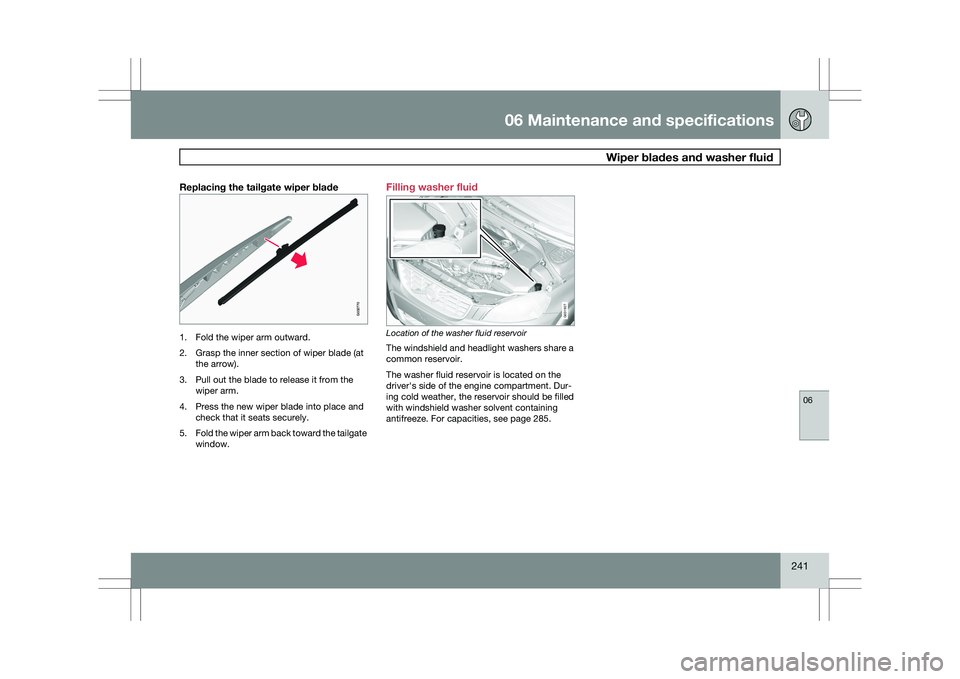
06 Maintenance and specifications
Wiper blades and washer fluid06
241
Replacing the tailgate wiper blade1. Fold the wiper arm outward.
2. Grasp the inner section of wiper blade (at
the arrow).
3. Pull out the blade to release it from the wiper arm.
4. Press the new wiper blade into place and check that it seats securely.
5. Fold the wiper arm back toward the tailgate
window. Filling washer fluid
Location of the washer fluid reservoir
The windshield and headlight washers share a
common reservoir.
The washer fluid reservoir is located on the
driver\fs side of the engine compartment. Dur-
ing cold weather, the reservoir should be filled
with windshield washer solvent containing
antifreeze. For capacities, see page 285. G032770 G031927
Page 244 of 297
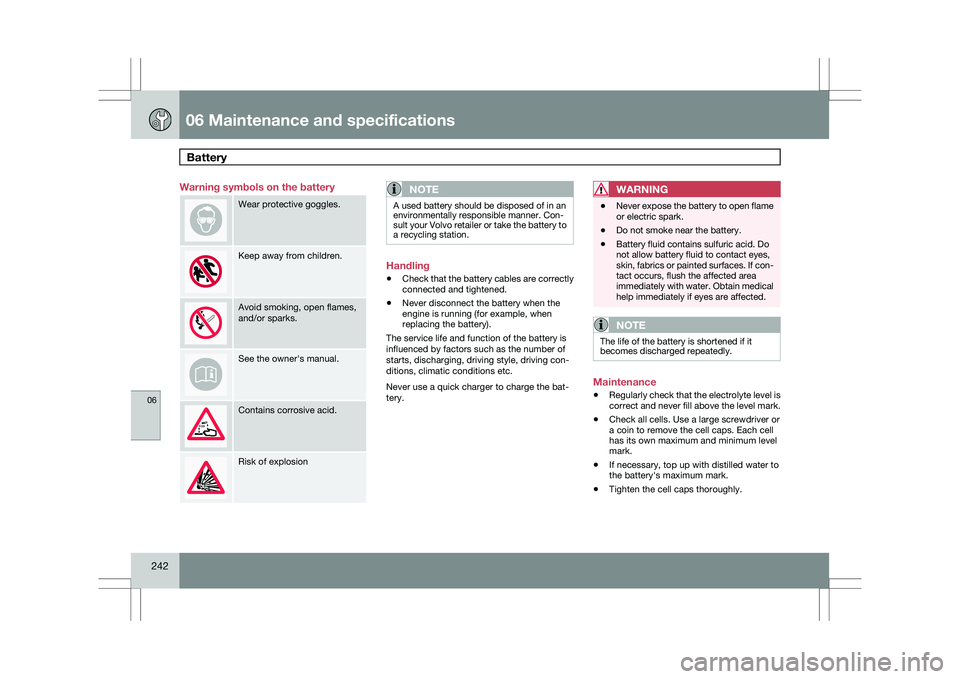
06 Maintenance and specificationsBattery 06
242 Warning symbols on the battery
Wear protective goggles.
Keep away from children.
Avoid smoking, open flames,
and/or sparks.
See the owner\fs manual.
Contains corrosive acid.
Risk of explosion
NOTE A used battery should be disposed of in an
environmentally responsible manner. Con-
sult your Volvo retailer or take the battery to
a recycling station.
Handling
\b
Check that the battery cables are correctly
connected and tightened.
\b Never disconnect the battery when the
engine is running (for example, when
replacing the battery).
The service life and function of the battery is
influenced by factors such as the number of
starts, discharging, driving style, driving con-
ditions, climatic conditions etc.
Never use a quick charger to charge the bat-
tery.WARNING \b
Never expose the battery to open flame
or electric spark.
\b Do not smoke near the battery.
\b Battery fluid contains sulfuric acid. Do
not allow battery fluid to contact eyes,
skin, fabrics or painted surfaces. If con-
tact occurs, flush the affected area
immediately with water. Obtain medical
help immediately if eyes are affected.
NOTE The life of the battery is shortened if it
becomes discharged repeatedly.
Maintenance
\b
Regularly check that the electrolyte level is
correct and never fill above the level mark.
\b Check all cells. Use a large screwdriver or
a coin to remove the cell caps. Each cell
has its own maximum and minimum level
mark.
\b If necessary, top up with distilled water to
the battery\fs maximum mark.
\b Tighten the cell caps thoroughly.
Page 245 of 297
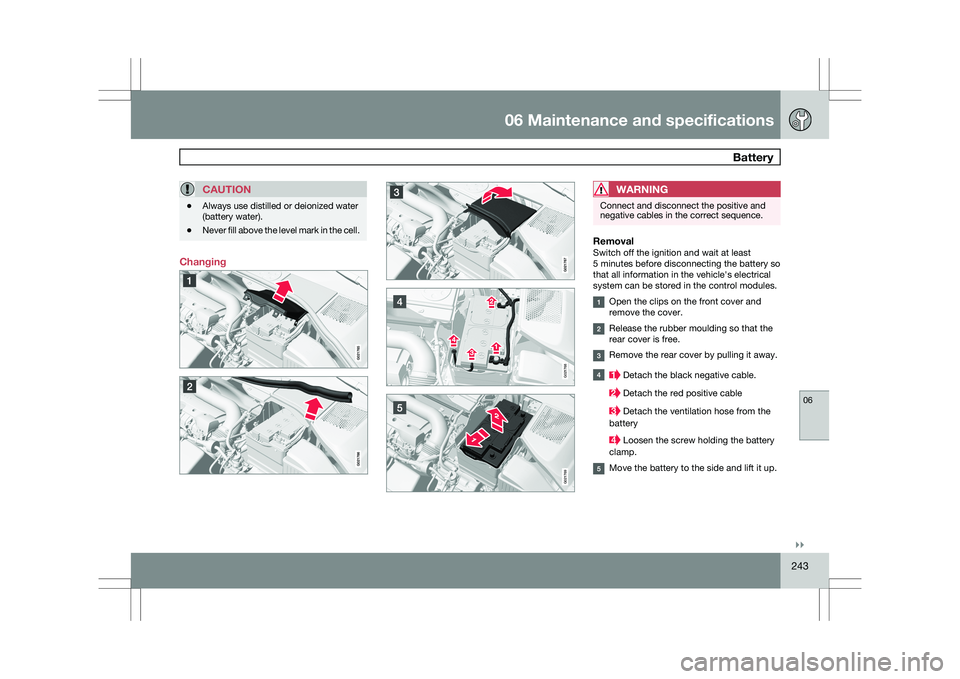
06 Maintenance and specifications
Battery06
}}
243
CAUTION\b
Always use distilled or deionized water
(battery water).
\b Never fill above the level mark in the cell. ChangingWARNING Connect and disconnect the positive and
negative cables in the correct sequence.
RemovalSwitch off the ignition and wait at least
5 minutes before disconnecting the battery so
that all information in the vehicle\fs electrical
system can be stored in the control modules.
Open the clips on the front cover and
remove the cover.
Release the rubber moulding so that the
rear cover is free.
Remove the rear cover by pulling it away.
Detach the black negative cable.
Detach the red positive cable
Detach the ventilation hose from the
battery Loosen the screw holding the battery
clamp. Move the battery to the side and lift it up. G021768 G021769
Page 246 of 297
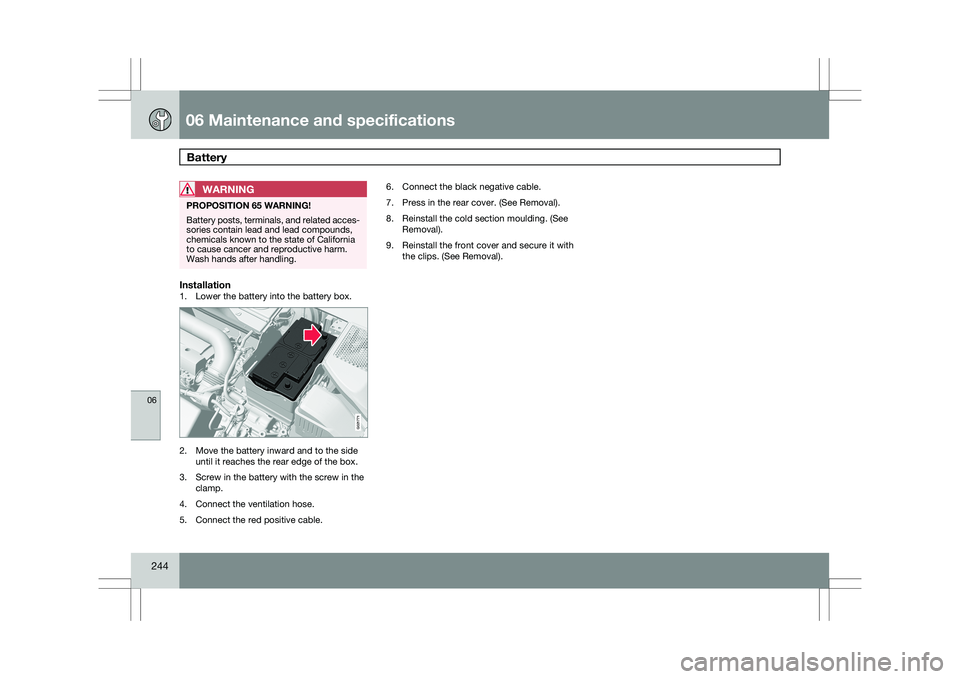
06 Maintenance and specificationsBattery 06
244
WARNING PROPOSITION 65 WARNING!
Battery posts, terminals, and related acces-
sories contain lead and lead compounds,
chemicals known to the state of California
to cause cancer and reproductive harm.
Wash hands after handling.
Installation1. Lower the battery into the battery box.
2. Move the battery inward and to the side
until it reaches the rear edge of the box.
3. Screw in the battery with the screw in the clamp.
4. Connect the ventilation hose.
5. Connect the red positive cable. 6. Connect the black negative cable.
7. Press in the rear cover. (See Removal).
8. Reinstall the cold section moulding. (See
Removal).
9. Reinstall the front cover and secure it with the clips. (See Removal). G021771
Page 247 of 297
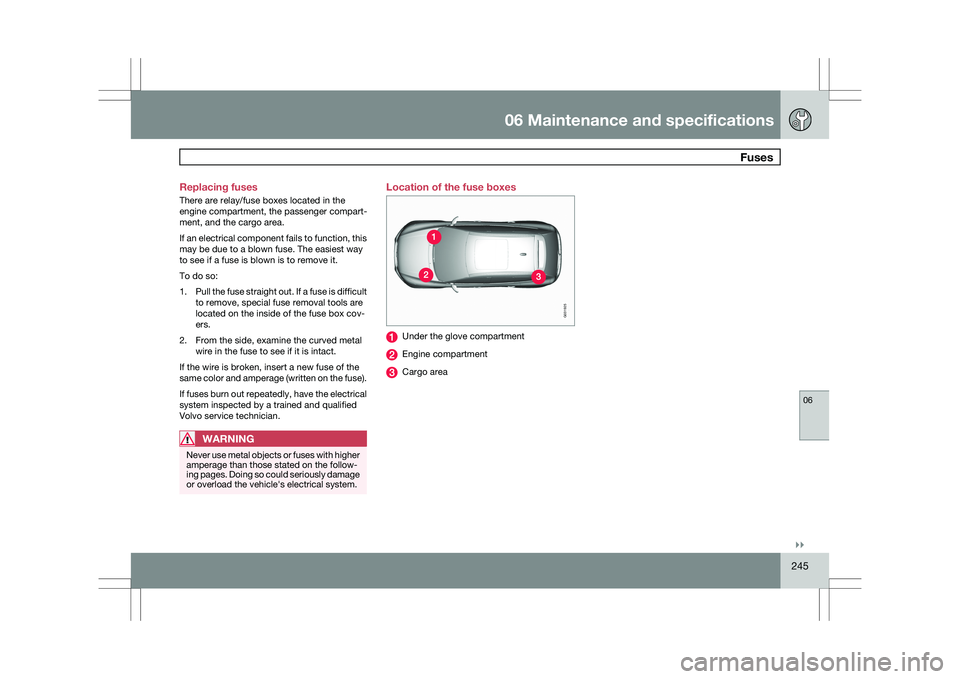
06 Maintenance and specifications
Fuses06
}}
245
Replacing fuses
There are relay/fuse boxes located in the
engine compartment, the passenger compart-
ment, and the cargo area.
If an electrical component fails to function, this
may be due to a blown fuse. The easiest way
to see if a fuse is blown is to remove it.
To do so:
1.
Pull the fuse straight out. If a fuse is difficult
to remove, special fuse removal tools are
located on the inside of the fuse box cov-
ers.
2. From the side, examine the curved metal wire in the fuse to see if it is intact.
If the wire is broken, insert a new fuse of the
same color and amperage (written on the fuse).
If fuses burn out repeatedly, have the electrical
system inspected by a trained and qualified
Volvo service technician.
WARNING Never use metal objects or fuses with higher
amperage than those stated on the follow-
ing pages. Doing so could seriously damage
or overload the vehicle\fs electrical system. Location of the fuse boxes
Under the glove compartment
Engine compartment
Cargo area G031925
Page 248 of 297
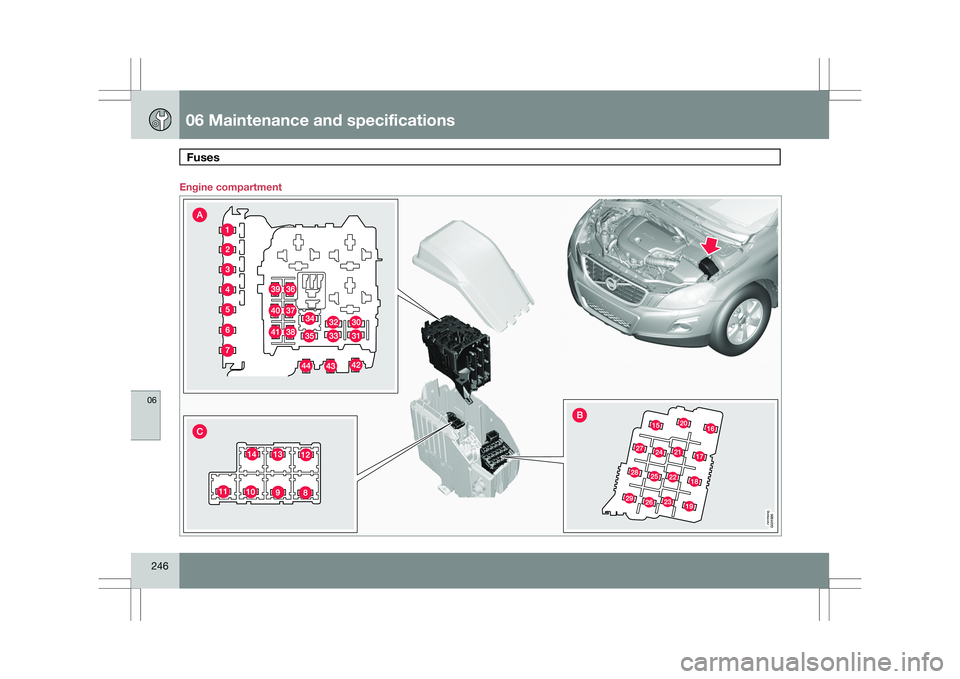
06 Maintenance and specificationsFuses 06
246 Engine compartment G025600G031926
Page 249 of 297
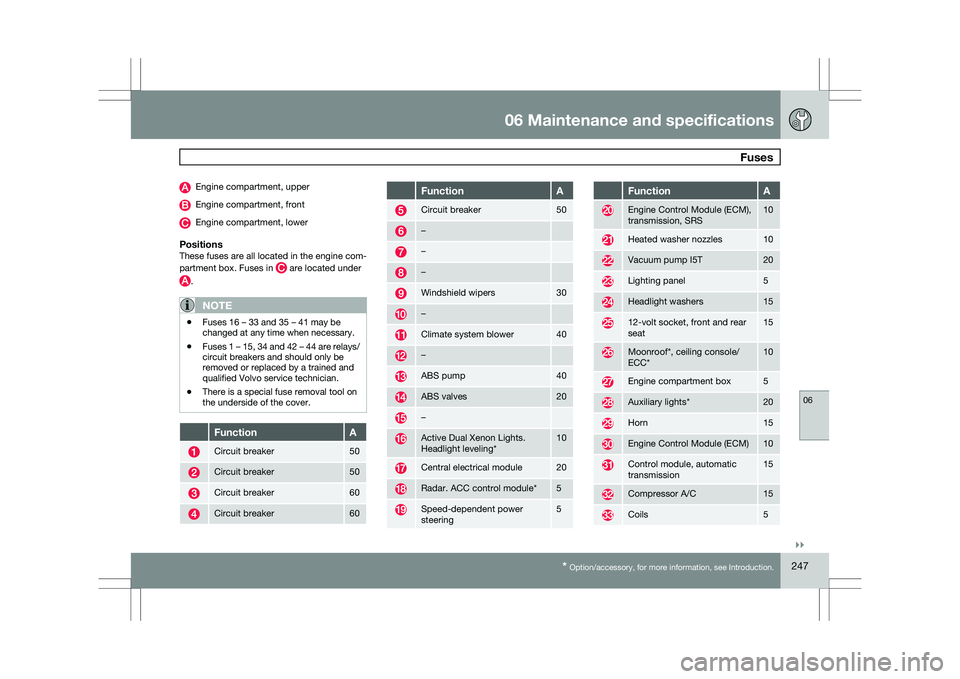
06 Maintenance and specifications
Fuses06
}}
* Option/accessory, for more information, see Introduction. 247Engine compartment, upper
Engine compartment, front
Engine compartment, lower
PositionsThese fuses are all located in the engine com-
partment box. Fuses in
are located under
.
NOTE
\b
Fuses 16 – 33 and 35 – 41 may be
changed at any time when necessary.
\b Fuses 1 – 15, 34 and 42 – 44 are relays/
circuit breakers and should only be
removed or replaced by a trained and
qualified Volvo service technician.
\b There is a special fuse removal tool on
the underside of the cover. Function A
Circuit breaker 50
Circuit breaker 50
Circuit breaker 60
Circuit breaker 60 Function A
Circuit breaker 50
–
–
–
Windshield wipers 30
–
Climate system blower 40
–
ABS pump 40
ABS valves 20
–
Active Dual Xenon Lights.
Headlight leveling
* 10
Central electrical module 20
Radar. ACC control module* 5
Speed-dependent power
steering 5 Function A
Engine Control Module (ECM),
transmission, SRS 10
Heated washer nozzles 10
Vacuum pump I5T 20
Lighting panel 5
Headlight washers 15
12-volt socket, front and rear
seat 15
Moonroof*, ceiling console/
ECC* 10
Engine compartment box 5
Auxiliary lights* 20
Horn 15
Engine Control Module (ECM) 10
Control module, automatic
transmission 15
Compressor A/C 15
Coils 5
Page 250 of 297
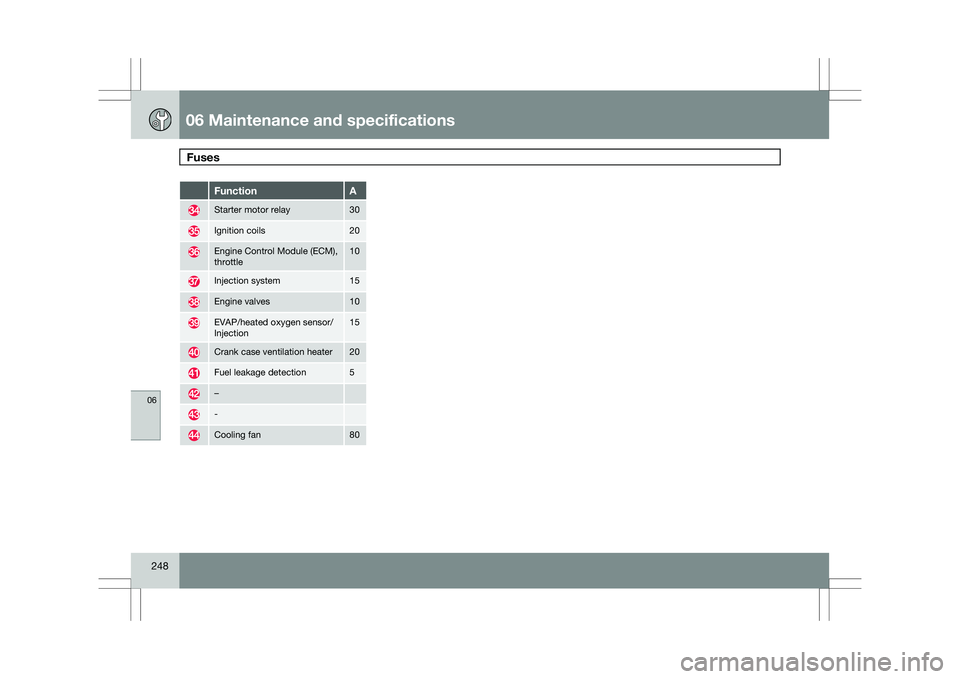
06 Maintenance and specificationsFuses 06
248 Function A
Starter motor relay 30
Ignition coils 20
Engine Control Module (ECM),
throttle 10
Injection system 15
Engine valves 10
EVAP/heated oxygen sensor/
Injection 15
Crank case ventilation heater 20
Fuel leakage detection 5
–
-
Cooling fan 80